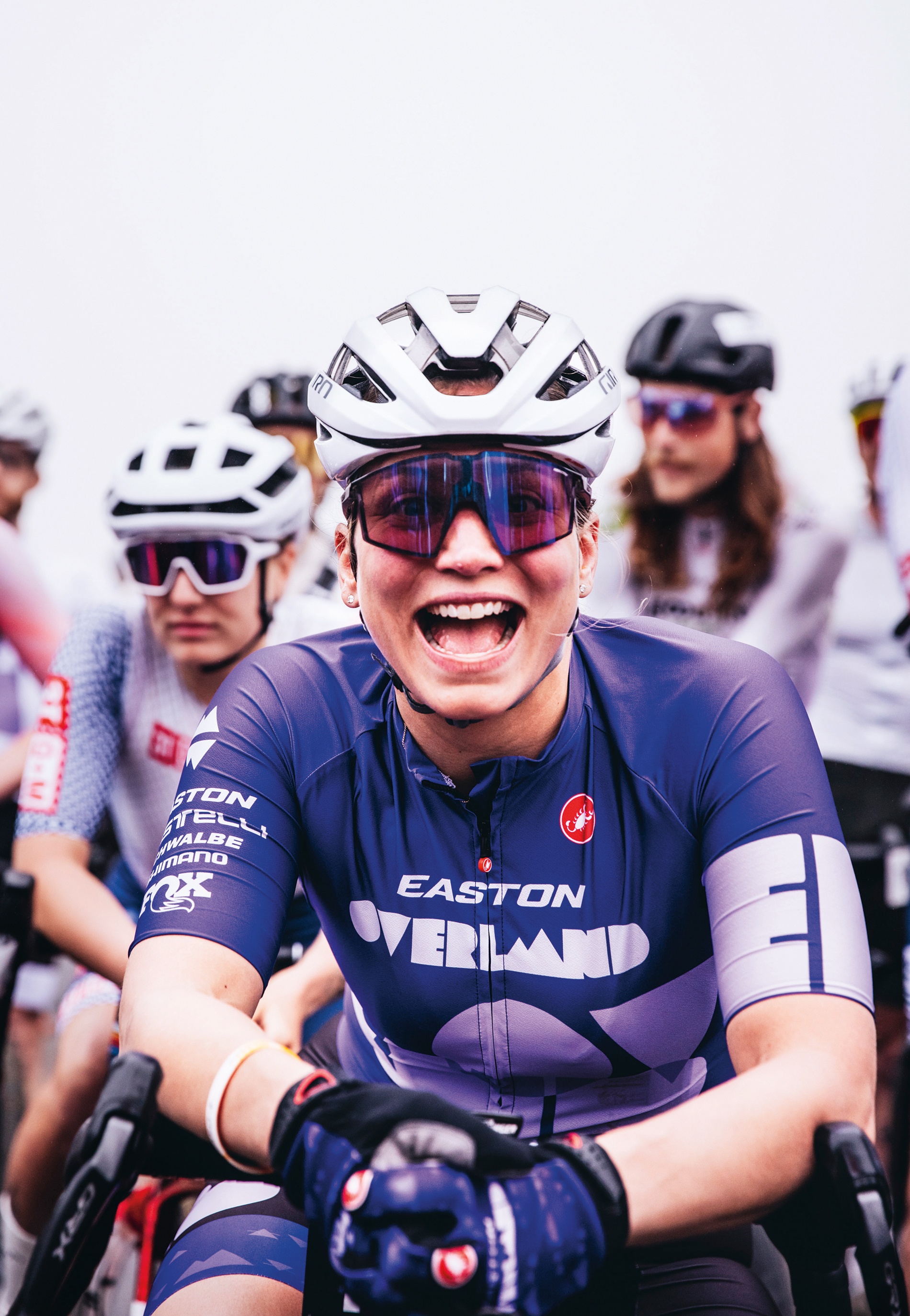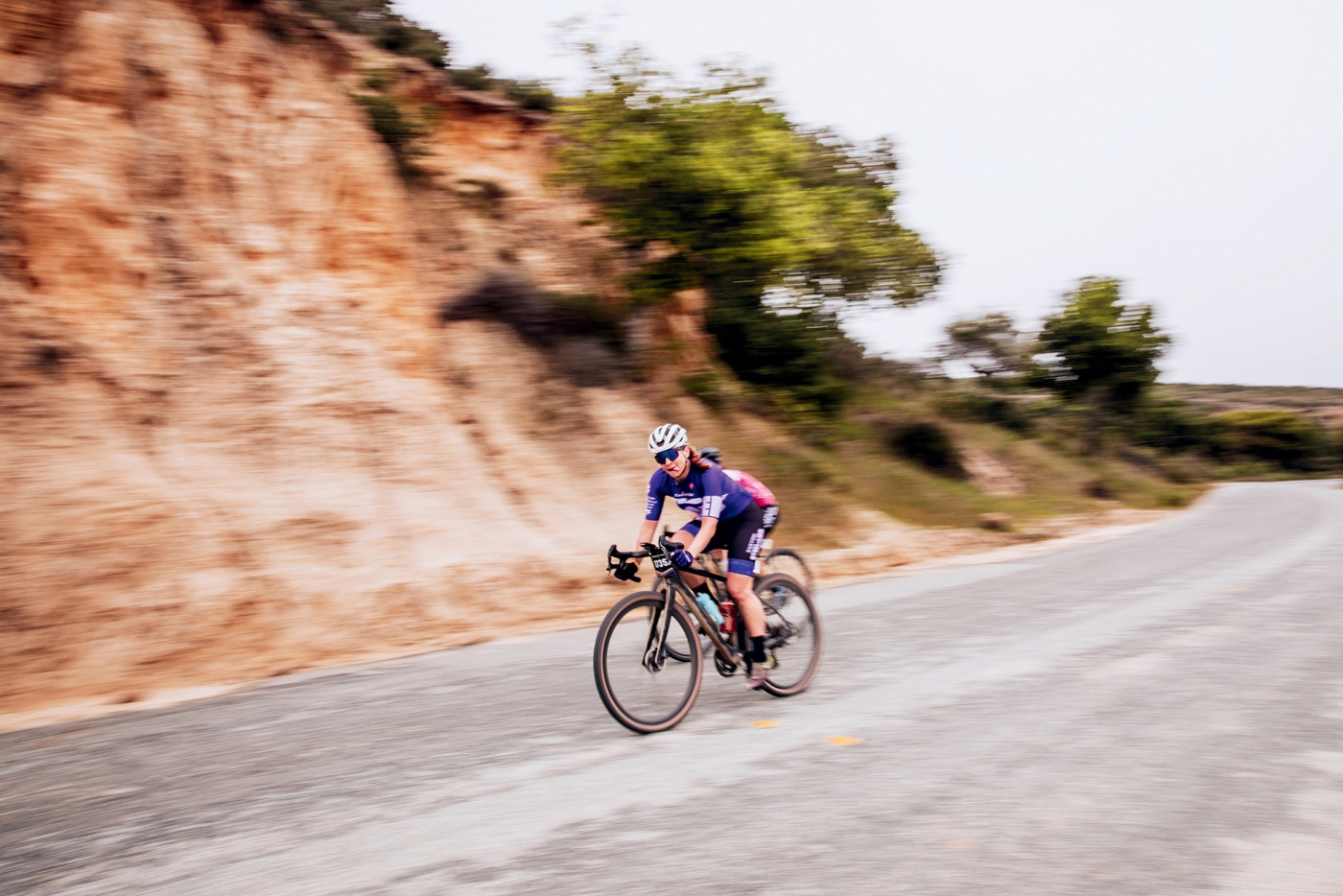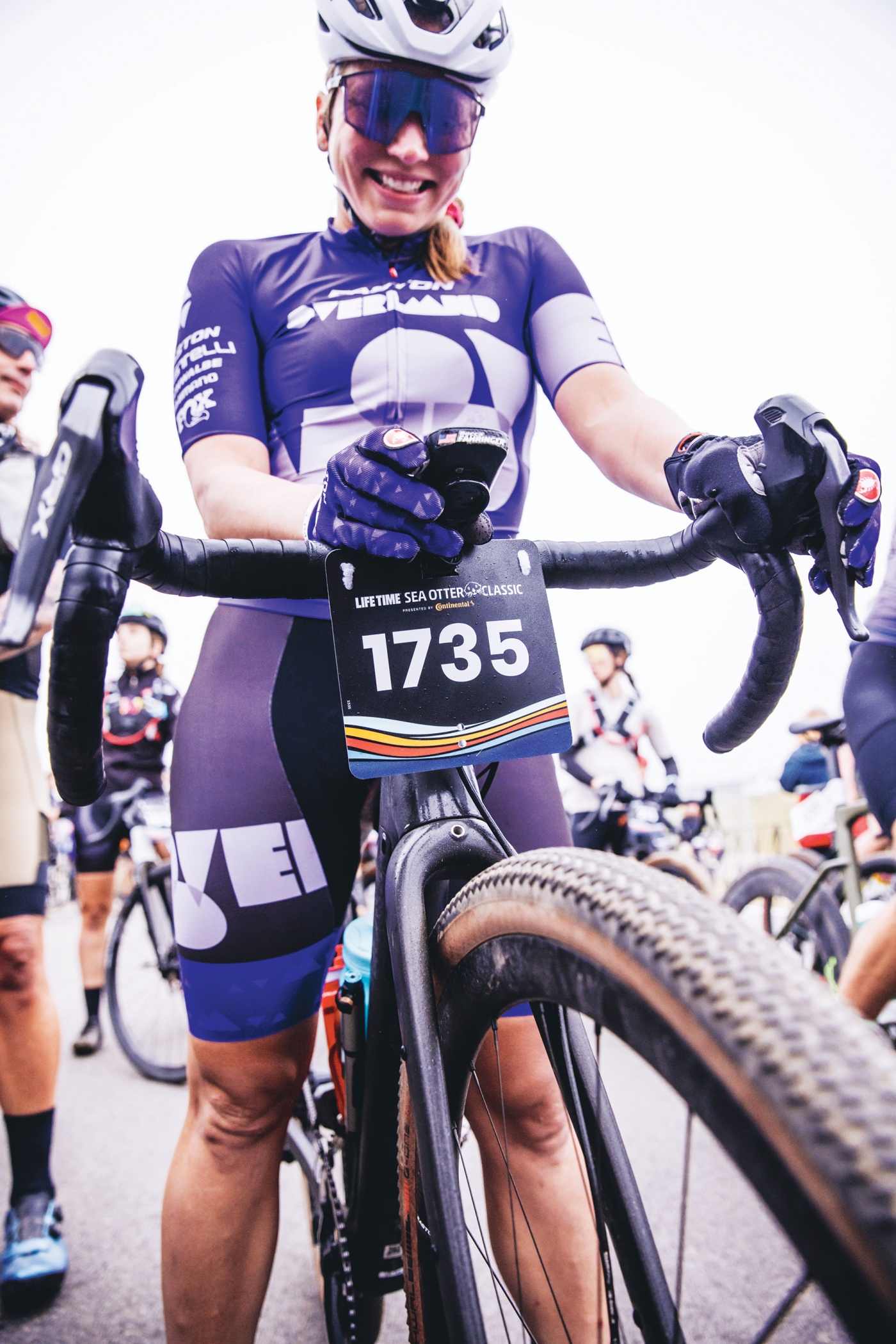
True Grit
Ten years ago, Rebecca Fahringer ’13 ScM went pro in the mud-and-rocks world of cyclocross. Several head injuries later, the fierce competitor has learned to play the long game.
A lot of people, after tumbling off a bicycle and sliding front-first across the ground, might get up, dust themselves off, and swear off bike-riding forever. Not Rebecca Fahringer ’13 ScM. After
face-planting during her very first cy-
clocross race in 2013, “I got up and I laughed,” she recalls. “And that’s where I fell in love with it.”
Falling is more or less a guarantee in cyclocross, a form of competitive cycling that involves traversing a roughly three-kilometer circuit dotted with obstacles in the form of thick mud, sand pits, steep hills, stairs, possibly even planks lodged horizontally into the ground. None of those things would be easy to navigate on a bicycle in normal circumstances—and, in fact, riders are sometimes forced to dismount and carry their bikes through the trickiest areas—but during a race, pedaling as fast as possible while jockeying for position against dozens of people, the difficulty ratchets up even further.
Fahringer was hooked. Even better, she was good. Although new to cyclocross, she wasn’t new to competitive cycling—she’d competed in triathlons as an undergraduate at the University of Dayton, then as part of Brown’s cycling team as she pursued a graduate degree in geological sciences. “I skyrocketed through the ranks, going from absolute unknown to finishing in the top portion,” she recalls of those first few months racing in New England.
In the spring of 2014, as she was wrapping up her master’s and beginning her job hunt, she found herself presented with two very different potential futures: a job offer from the Department of the Interior, or a roster spot on the JAM Fund, a well-respected cyclocross development team based out of Massachusetts.
She decided to give full-time cycling a shot. You only live once, she reasoned. “Maybe it seems silly to give up a cool job in the federal realm with real-life human benefits to ride a bicycle, but that’s what I’m doing,” she told the Department of the Interior employee over the phone. But the woman surprised her: “You know what, that’s a good idea. You do only live once. If you break your leg, go ahead and give us a call.”
Feel the fear
A good day for cyclocross is the kind of day when everyone else stays inside. The official season runs from September through February; ideal racing conditions are cold, rainy, and, consequently, muddy. Ice and snow are also possible, but winters in Belgium—the unofficial but undisputed world capital of cyclocross—typically hover around 40 degrees Fahrenheit. Riders crossing the finish line typically range from mud-splattered to mud-soaked.
It makes for a dramatic finish, but the mud is tough on equipment. So cyclocross courses feature “pits” where elite riders with dedicated pit crews can swap their mud-caked bikes for fresh ones. As part of a development team, Fahringer had that sort of support from the start: “I was really, really lucky to get picked up so fast.”
Soon, she was landing podiums—and, in 2015, she got picked up by the Amy D. Foundation, another development program that ran parallel to the Raleigh Clement professional cyclocross team. “I was essentially a professional rider within my second year,” she says. She made four podiums that year, and placed sixth at U.S. Nationals in 2016.

But despite these early successes, Fahringer was still fundamentally new to the sport. Although she had the strength and power to place, her bike-handling skills were shaky. “It sounds so silly, like I would be in the top 10 or 20 of professional level races of off-road cycling, and I was afraid to ride off a curb,” she says. Any technical elements, like roots or rocks or steep inclines, left her anxious and intimidated.
It was her then-boyfriend who eventually helped her conquer those fears. Together, they would drive out to a gravel or sand pit, walk their bikes to the top, and he’d tell Fahringer to ride to the bottom. She would hesitate, nervous. “He’s like ‘What’s the worst that happens? You’re gonna fall down.’ Basically, he just gave me really controlled places to experience those feelings of fear and danger and come to grips with them outside of the race environment—which is not a great time to tackle your fears.”
Her technical skills solidified as she continued to race, but nowhere as clearly as the UCI World Cup in Namur, Belgium—one of the best-known races on the cyclocross circuit, and Fahringer’s personal favorite. The course is famously muddy. The steep off-camber section, where competitors ride horizontally along the side of a hill, is iconic. Years of racing have carved narrow tracks into the slope that provide a sliver of flat ground, but if a hidden root knocks a rider’s wheel out of alignment, they’ll find themselves sliding down the hill into the webbed fencing below.
And then there’s the “mandatory run,” where riders are required to shoulder their bikes and sprint up a hill. At the top, they’re greeted by a hairpin turn with just enough space to take a single step, remount the bike, and launch themselves down a muddy descent with another turn at the bottom—all before they’ve even gotten a chance to clip their feet into the pedals.
“It’s just one of the gnarliest cyclocross races out there,” Fahringer says. “My first year, I was standing at the top crying, not wanting to go down. And then, my last year, I was running past crowds of people, not even hesitating, as I ran up one side, jumped on my bike and plunged down the other. It’s the only race on the circuit that by the last time I did it, I still had a little bit of fear.”
Dazed and determined
By the 2019-2020 season, Fahringer had hit her stride. She snagged a third-place finish at the Pan-American Cyclocross Championships and a silver at U.S. Nationals. Across the pond, she placed eighth at Namur and 13th at the UCI World Championships in Dübendorf. In March 2020, she embarked on a cross-country move from New Hampshire to Oregon with the intention of “going all in” on the 2020-2021 cyclocross season.
The season did not go as planned—not for Fahringer and not for the world. Covid-19 hit, and suddenly races all across the U.S. were being canceled. She temporarily relocated to Belgium, where races were still taking place. During the second weekend of the season, she hit a hole while riding down a steep incline and was launched straight over her handlebars. Instead of sliding, Fahringer slammed straight into the ground—her momentum stopping so abruptly that her brain knocked against her skull, despite her head never actually hitting the ground. She was concussed, but in the moment, she was “in denial.” Dazed but determined, she picked herself up and finished the race.
It took fainting in a hotel hallway two days later for her to acknowledge there was a problem. Even then, she took only a few days off before racing again, struggling through the rest of the season; she placed in the top 10 only twice out of 22 races.
Then, in a cruel moment of déjà vu, another cyclist crashed into her during her first weekend racing in the 2021-22 season. She slid out, hitting her head and sustaining a second concussion. Since then, it’s been a slow, fitful road toward recovery.
Pro cycling comes with its fair share of physical risks, from broken collarbones to concussions. The path to recovery is a lot less straightforward for head injuries, however. Doctors sometimes say that concussions are like snowflakes—no two are alike, and neither are their treatment plans. A full recovery can take anywhere from a few weeks to multiple years.
Even now, Fahringer is still feeling the lingering effects. To avoid headaches caused by bumpy cyclocross courses, she’s shifted her focus to gravel and mountain biking. (It’s not uncommon for professional cyclists to switch between disciplines, since a lot of the skills are transferable.) These races are longer than cyclocross—hundreds of miles, often spaced out over the course of several days.
There have been bright spots—a first-place finish at the 2022 Belgian Waffle Ride Kansas, a 123-mile gravel race, for instance—but there were also plenty of lows. She cut her 2023 season short after running low on energy and funds. In November, her sponsor Kona Bikes announced they were disbanding their racing program entirely. It gave her a moment to step back and reassess. This year, she’s joined a new team with fewer demands on her time, the Easton Overland gravel squad. Although their equipment and entries are covered, she’s technically not a professional athlete this season since she’s not getting paid to race. “I’m taking a year to figure out how real life works. And it turns out, after a decade, and multiple injuries, I was exhausted.”
Fahringer is rediscovering some of the parts of life that she gave up when she turned down that position with the Department of the Interior. For the first time in a decade, she has a full-time job; she’s a project manager at UL Solutions, an international science safety company, where she focuses on wind and solar farms. Certain things are exciting about that, like healthcare benefits and paychecks. (“It’s really cool getting paychecks. Like, nobody really warns you about how cool it is. But it turns out it’s pretty great.”)
She’s still racing, too. One quirk of the cycling world, at least for disciplines like gravel, is that everyone—professionals and weekend warriors alike—race side-by-side at many of the season’s events. Which means she’s still competing against the same talent pool, despite her new team. And the results have been encouraging—this summer, so far, she’s placed 5th at the Life Time Sea Otter Classic in Monterey, 2nd at the 144-mile Cascade Gravel Grinder in Oregon, and 3rd at Lost and Found Gravel in Portola, California.

“It’s sort of the best of all worlds, because I still get to hang out in the cycling industry and show up to whatever races I want but have absolutely no pressure. I don’t get frustrated if I don’t do well. I don’t need to train when the weather is icky. I have family vacations planned. That’s crazy. I haven’t really seen my family much for the last ten years.”
Plus, women in pro cycling can play the long game. “We don’t age out of endurance sports” in the same way as men, she explains. It’s not unheard of for women to go pro in their late 30s or even in their 40s. Fahringer’s only 35; she’s got time, if she decides she wants back in.
Social-media sweetness
One silver lining of these last few tumultuous years is that Fahringer may have stumbled upon the only nice place on the internet. After her first head injury in Belgium in 2020, she started posting vlogs of her races, filming with a GoPro and giving people an unvarnished look at the life of a professional cyclist—both the ups and the downs.
She expected heckling. That’s not what she got. “Instead of people saying, ‘You suck, just go home. Stop complaining. Cheer up,’ people were like, ‘You’re doing so well. You’re really empowering everyone. Keep trucking.’” It came at a critical time. Traumatic brain injuries have been linked to higher rates of depression, and Fahringer experienced both depression and anxiety after her first concussion, further compounded by the fact that she was struggling to finish races and isolated in a foreign country.
“I don’t think I experienced a negative comment the entire time I was there,” she says. Unlike within a lot of other professional sports, most cycling fans are also cyclists themselves. For that reason, Fahringer suspects they may be a kinder, more empathetic audience. “They can truly identify with whatever pros are doing, whether it’s coming back from an injury, overcoming a bad race…. It’s been really nice to have people in my corner—even complete strangers saying, like, ‘Hey, we’ve watched your journey over the past ten years or three years, and it’s really empowering to see that you haven’t given up.’”
These days, she posts her videos primarily on Instagram, an eclectic mix of comedic commentary on other people’s viral videos of dangerous bike stunts, poetic odes to the sport of cyclocross, updates on her most recent race results, and the difficulty of a cycling career not going to plan.
“Sometimes the commenters say really cheesy things that aren’t necessarily true, like, ‘So glad you stuck with it even when you weren’t winning. It shows that you don’t even care if you win or not,’” Fahringer says. “I do care. It’s been a big mental and emotional battle on that front. But it’s also super rewarding to know that maybe my pedaling isn’t completely fruitless, even if it’s not winning races. That it means something to some people. That maybe it helped someone else out there get back on the bike—maybe metaphorically, maybe literally—and keep going.”
Abigail Cain ’15 is a freelance writer and a content strategist at BuzzFeed.





